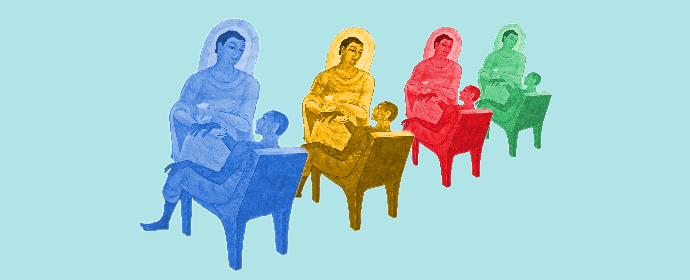In Focus: Sūtras for Well-Being
In response to the unique challenges this year has brought, 84000 has been building upon its first, fully digital outreach initiative to support its global community in feeling inspired, connected, and uplifted. The Sūtras for Well-Being series shares a curated selection of texts from the Tibetan Buddhist Canon, and offers our friends a multimedia look at the sūtras traditionally recited for resilience and well-being in times of adversity, and the stories behind them.

As people around the world entered into successive waves of Coronavirus-induced anxiety and sufferings, many of our friends asked us for inspiring content to help alleviate anxiety during these challenging times of distancing, quarantines, and lockdowns. Each month since June, we have been announcing the publication of a new text in this series, and over the course of a few weeks we bring its contents to life for our audiences. With its announcement, friends are encouraged to read the text in our online Reading Room and to use our interactive features to really engage with the meanings of the translation. Soon after, we share two audio recordings of the sūtra: One, chanted in Tibetan by a master of the living tradition; and the second, read aloud in English by one of our general readers. This personal study and aural inspiration, are complemented by an IGTV video of up to ten minutes, in which members of our wider editorial team help to open a window into the context, significance, peculiarities, and stories behind the given sūtra. Through this multi-faceted approach, we hope to really inspire a sense of well-being in our audiences.
An inherently collaborative organization, 84000 always takes great care to maintain a fine balance of support: This ranges from the devoted contributions of the Indo-Himalayan teachers of the living tradition, to the insight and inquiry of academics from western-modeled universities, and it extends to a global community of practitioners and readers. So, including a balanced representation in this series was essential in creating a quality of inclusivity and accessibility, allowing everyone to connect, to be inspired, and to focus the mind in times of such uncertainty.
In our first week, we shared a short text called, The Mahāsūtra “On Entering the City of Vaiśālī” which is an extract from a translation of the Bhaiṣajyavastu (“The Chapter on Medicines,” the sixth chapter of the Vinayavastu, Toh 1), in which the Buddha is invited to Vaiśālī while it is being ravaged by a terrible epidemic. The Buddha instructs Ānanda to stand at the city’s gate and recite a proclamation, a long mantra, and some verses that powerfully evoke spiritual well-being. Ānanda does so, and the epidemic comes to an end.
The publication of this text was followed by two Soundcloud tracks: One in which Dzongsar Khyentse Rinpoche chants the sūtra in Tibetan, echoing the way in which this text, like other accounts of this incident, have traditionally been recited during times of personal or collective illness and difficulty. And we asked British musician Gary Dyson to help create a correlative chant in English.
Over the centuries, translation has proved integral to the survival of the Buddhadharma, and at 84000—with over one hundred texts now published online in English—we encourage the exploration of the Buddhadharma in modern languages. This episode of Sūtras for Well-Being was complemented by a four-minute IGTV video in which our editorial co-director, Dr. John Canti shares with us his insights into the text and its story. To view all the well-being videos, visit our Well-Being page: www.84000.co/wellbeing
In the following weeks, this pattern was repeated with each publication, and in this way we have been able to capture precious voice recordings of authentic teachers—such as H.H. 41st Sakya Trichen, Garchen Rinpoche, Jigme Khyentse Rinpoche, and Pema Wangyal Rinpoche—as they chant aloud these texts. Their continued support for our work and vision has been truly humbling.
- Garchen Rinpoche
- Jigme Khyentse Rinpoche
- H.H. 41st Sakya Trichen
- Pema Wangyal Rinpoche
This series’ texts are selected for their contextual parity and for their potential to offer readers the resilience needed to navigate their lives today. Over millenia, the words of the Buddha have been a source of inner strength and wisdom, and as a tool for shifting perspective. Particularly well-received in this series have been the texts that feature the popular Tibetan deity, Tārā, such as: Tārā Who Protects from the Eight Dangers, The Dhāraṇī of Parṇaśavarī, and Praise to Tārā with Twenty-One Verses of Homage. The video insights of our strong editorial team and translators has allowed our readers to engage more deeply with these Kangyur texts.
In such videos, the iconic Dr. Jan Willis talks us through the legends of Tārā’s origins, the correspondence between the eight outer and inner dangers, and how relevant prayer to Tārā is in our current circumstances. 84000 editor Ryan Damron illustrates Parnaśavarī’s piśācī characteristics, the development of her iconography over centuries, and her dual nature as both a piśācī and a powerful realized being who can protect us from, and neutralize, the very dangers associated with piśācīs. And Dr. Sangseraima Ujeed talks about the “swiftness” of Tārā’s activities, and how it is said that during times of natural disasters, and especially infectious disease, this praise of homage is seen to be even more effective for achieving quick results in helping sentient beings.
- Dr. Jan Willis
- Ryan Damron
- Dr. Sangseraima Ujeed
We hope that these digital offerings help bring compassion and inspiration to all, a little bit of relief to those that need, a reminder to remain cognizant of the fact that all things will pass, and above all, we hope that this series may be another source of resilience and well-being for everyone.
Posted: 18 Nov 2020







